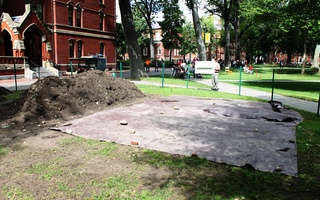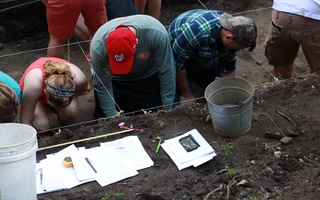The remnants of silver saltcellers and forks on display in the Peabody Museum reveal more about the history of Harvard than might at first be obvious. In the 17th century, tableware, rather than designer bags, served as college status symbols; students weren’t provided with silverware and would instead bring their own. Those who couldn’t afford to do so, however, were forced to eat with their hands. The “Digging Veritas” exhibition at the Peabody Museum displays these items and others uncovered over several years of Archaeology 1130/1131: “Archaeology of Harvard Yard,” and explains their social implications.
First offered in 2005, Archaeology 1130 is about to break ground for the third time. The first batch of Archaeology 1130/1131 students began digging in tandem with plumbing updates in front of Massachusetts Hall. Through studying 19th-century maps of the Yard and performing a ground-penetrating radar survey, professors discovered that the foundations of the Indian College founded by a charter in 1655 lay underneath Matthews Hall. Professor Christina Hodge describes the course as “an unusual kind of course at Harvard. There aren’t that many courses where students literally have their hands in the dirt.”
The small but well-edited collection in the Peabody Museum explores three aspects of life at 17th-century Harvard: negotiations of social status, rule breaking and religion, and literacy and the Indian College. Artifacts related to the serving and eating of food provide evidence of social tensions. Shards of dishes and tableware point to officially mandated classism; wealthy students paid double the normal tuition, and in return ate delicacies such as fruit on tables set with dishes, tablecloths, silver, and pewter, while the other students ate off of wooden trenchers.
Although Harvard abided by a number of Puritan-inspired rules, students found pieces of pipes, mugs, and wine bottles that denoted a tradition of openly flouting the rules. “It’s pretty much all we find,” says head teaching fellow Michele Koons. “There’s more [drinking and smoking] paraphernalia than in some tavern sites.”
Perhaps the most impressive finds, though, were the fragments of moveable type from the first printing press in North America—the one housed in the Indian College. The small strips of metal that students uncovered actually played an important role in the development of American print culture. The Eliot Bible, the first published work in North America, was produced on the Indian College press in the local Algonquian language.
“Digging Veritas” represents not only the physical excavations from multiple digs, but also the effects of years of cooperation between students, teachers, the public, and the original stakeholders in Harvard College—the local Native Americans, specifically the Wampanoag tribe. An overarching theme of the course, besides offering tangible archaeology experience, is to facilitate a discourse with the local Native Americans who had been ignored for 300 years. Although the 1655 charter of Harvard College stated its goal was “the education of the English and Indian Youth of this Country in knowledge: and godliness,” it was only after the 1990 Native American Graves Protection and Repatriation Act that federal funds supported the long process of ethnographic repatriation.
“This exhibit represents not only what students saw as important, but also what natives wanted to emphasize,” says Koons. This attention to the importance of the Indian legacy at Harvard is a vital part of the exhibition. Professor Hodge notes that, despite troubling episodes of classism and racism in Harvard’s history, “It was really a place where different people were coming together, a belief which we still try to perpetuate.”
Read more in Arts
Let Dwight Die with Dignity: Euthanize ‘The Office’

















